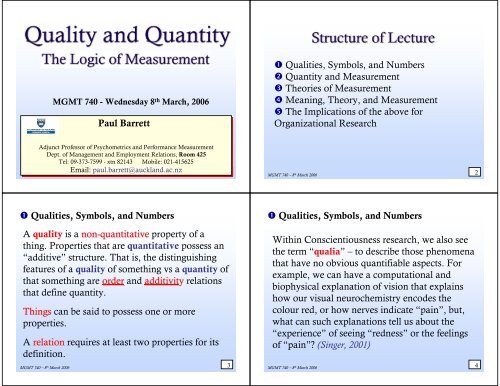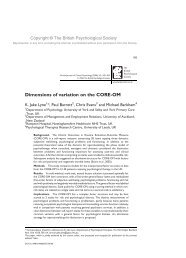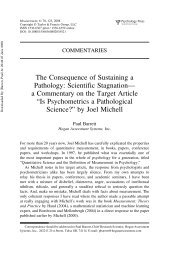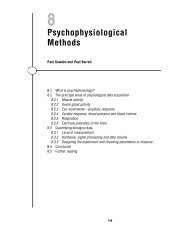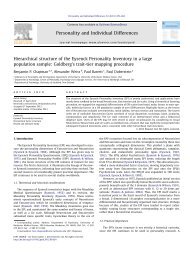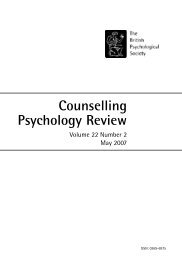Here - Paul Barrett
Here - Paul Barrett
Here - Paul Barrett
Create successful ePaper yourself
Turn your PDF publications into a flip-book with our unique Google optimized e-Paper software.
MGMT 740 - Wednesday 8 th March, 2006<strong>Paul</strong> <strong>Barrett</strong> Qualities, Symbols, and Numbers Quantity and Measurement Theories of Measurement Meaning, Theory, and Measurement The Implications of the above forOrganizational ResearchAdjunct Professor of of Psychometrics and and Performance MeasurementDept. of of Management and and Employment Relations, Room 425 425Tel: Tel: 09-373-7599 --xtn xtn82143 Mobile: 021-415625Email: paul.barrett@auckland.ac.nz 12MGMT 740 – 8 th March 2006 Qualities, Symbols, and Numbers Qualities, Symbols, and NumbersA quality is a non-quantitativeproperty of athing. Properties that are quantitative possess an“additive” structure. That is, the distinguishingfeatures of a quality of something vs a quantity ofthat something are order and additivity relationsthat define quantity.Things can be said to possess one or moreproperties.A relation requires at least two properties for itsdefinition.Within Conscientiousness research, we also seethe term “qualia” – to describe those phenomenathat have no obvious quantifiable aspects. Forexample, we can have a computational andbiophysical explanation of vision that explainshow our visual neurochemistry encodes thecolour red, or how nerves indicate “pain”, but,what can such explanations tell us about the“experience” of seeing “redness” or the feelingsof “pain”? (Singer, 2001)MGMT 740 – 83th March 2006 MGMT 740 – 84th March 2006
Qualities, Symbols, and NumbersA symbol is something that represents or standsfor something else. It can be a sign, a number,letter, or object. However, it possesses no specialproperties or features that convey any moremeaning or understanding than that associatedwith the representation relation between thesymbol and the object or feature it represents. So,when a number is used to represent a responseoption on a questionnaire say, the numberremains solely a symbol, unless explicitconditional relations are imposed between thesymbols and represented objects or features. Qualities, Symbols, and NumbersA number is a relation, which requires at leasttwo properties of a thing for its definition.The specific relation here is betweenmagnitudes of quantity on the same attribute,with the specific definition of a number as aratio of two magnitudes of quantity on thesame attribute.MGMT 740 – 85th March 2006 MGMT 740 – 86th March 2006 Qualities, Symbols, and NumbersNatural Numbers: cardinal numbers used torepresent the sizes of distinct collections ofobjects as positive valued, non-zero, integers.E.g. 1, 2, 3, 4… etc. As in 4 books (e.g. the ratioof 4 books relative to 1 book), 15 students, 200cars, 5,000 employees.Integer Numbers: whole valued numbers thanmay vary between positive and negative values,and which include the value 0. The ratiobetween two magnitudes of a quantity – say 10and 5, as in 10÷5, is the integer 2. Qualities, Symbols, and NumbersRational Numbers: ratios of two integers,which can be represented as finite-valued“fractions”. E.g. 15÷4 = 3.75. The number3.75 is a rational number.Irrational Numbers: a number which cannotbe represented as a finite-valued fraction. E.g.the square root of 2, the value of pi (π)MGMT 740 – 87th March 2006 MGMT 740 – 88th March 2006
Qualities, Symbols, and Numbers Qualities, Symbols, and NumbersReal Numbers: ratios of two continuousvaluedmagnitudes of quantity. A magnitudeof a quantity is (in the abstract), infinitelyindivisible (for example, a magnitude oflength can be divided into smaller whole partsof length, and infinitely smaller parts of theseparts etc.). In short, taking the ratio of suchmagnitudes yields numbers which arethemselves continuous-valued.What will MGMT 740 students need toremember …?The difference between integer and realvaluednumbers!Integers are whole numbers (0, 1, 2, 4 etc.)Real numbers have a fractional part. E.g.2.5713 (the “5713” is the fractional part).MGMT 740 – 89th March 2006 MGMT 740 – 810th March 2006 Quantity and MeasurementQuantity: an attribute possessing ordinal andadditive structure. For example, length is aquantity because lengths are ordered accordingto their magnitude, and each specific length isconstituted additively of other specific lengths Quantity and MeasurementMichell (1990), p.63 ..." measurement is a procedure for identifyingvalues of quantitative variables through theirnumerical relationships to other values. Take asimple example. We wish to know the length ofa timber beam. This may be done by relating itslength to that called a meter. It is to be found rmeters long (where r is some real number).<strong>Here</strong> r is the ratio of the length of the beam to that ofa meter and this FACT enables the length of thebeam to be characterized…”MGMT 740 – 811th March 2006 MGMT 740 – 812th March 2006
Quantity and Measurement Quantity and Measurement“More generally, in measurement some(unknown) value of a quantitative variable isidentified as being r units. A UNIT ofMEASUREMENT is simply a particular valueof the relevant variable. It is singled out as thatvalue relative to which all others are to becompared.”“Let the unit be Y and let the value to bemeasured be X. Then a measurement has theform X = rY....Measurement requires the development ofprocedures whereby values X and Y may bebrought into comparison and their ratioassessed. Such procedures are the methodsof measurement"MGMT 740 – 813th March 2006 MGMT 740 – 814th March 2006 Quantity and Measurement Quantity and MeasurementMichell (2001), p. 212 …“Measurement, as a scientific method, is a wayof finding out (more or less reliably) what level ofan attribute is possessed by the object or objectsunder investigation. However, because measurementis the assessment of the level of an attribute via itsnumerical relation (ratio) to another level of the sameattribute (the unit selected), and because onlyquantitative attributes sustain ratios of this sort,measurement applies only to quantitative attributes.A variable is anything relative to which objectsmay vary. For example, weight is a variable,different objects can have different weights, buteach object can only possess one such weight atany point in time. A quantitative variablesatisfies certain conditions of ordinal andadditive structure. For example, weight is aquantity because weights are ordered accordingto their magnitude, and each specific weight isconstituted additively of other specifiedweights. Likewise lengths.MGMT 740 – 815th March 2006 MGMT 740 – 816th March 2006
Quantity and Measurement Quantity and MeasurementSpecifically (from Michell, 1990), p. 52-53) …“The first fact to note about a quantitativevariable is that its values are ordered. Forexample, lengths are ordered according to theirmagnitude, 6 meters is greater than 2 meters,and so on. Similarly the values of otherquantitative variables are ordered according totheir magnitudes.Specifically (from Michell, 1990), p. 52-53) …“… The familiar symbols, “≥” and “>” will beused to denote this relation of magnitude,“≥” meaning “at least as great as”, and“>” meaning “greater than”. Also the symbol“=” will be used to signify identity of value.MGMT 740 – 817th March 2006 MGMT 740 – 818th March 2006 Quantity and MeasurementLet X, Y, and Z be any three values of a variable, Q.Then Q is ordinal if and only if:1) if X ≥ Y and Y ≥ Z then X ≥ Z (transitivity)2) if X ≥ Y and Y ≥ X then X = Y (antisymmetry)3) either X ≥ Y or Y ≥ X (strong connexity)A relation possessing these three properties is called asimple order, so Q is ordinal if and only if ≥ is a simpleorder on its values. All quantitative variables aresimply ordered by ≥ , but not every ordinal variable isquantitative, for quantity involves more than order. Itinvolves additivity. Quantity and MeasurementAdditivity is a ternary relation (involving three values),symbolized as “X + Y = Z”. Let Q be any ordinalvariable such that for any of its values X, Y, and Z:4) X + (Y + Z) = (X + Y) + Z (associativity)5) X + Y = Y + X (commutativity)6) X ≥ Y if and only if X + Y ≥ Y +Z (monotonicity)7) if X > Y then there exists a value of Z such thatX = Y + Z (solvability)8) X + Y > X (positivity)9) there exists a natural number n such that nX ≥ Y(where 1X = X and (n + 1)X = nX + X)(the Archimedian condition)MGMT 740 – 819th March 2006 MGMT 740 – 820th March 2006
Quantity and MeasurementThese nine conditions were stated by J.S. Mill in1843, and later by Hölder (1901) within hisexposition of the axioms of quantity. However, asMichell (1999) points out, the influence ofEuclid’s theory of magnitudes is presentthroughout the historical development of thephysical sciences, and especially within Newton’sPrincipia of 1728. In short, this is not some pieceof ad-hoc philosophy produced to support aconvenient argument, but rather, these are thebases for quantitative measurement that hasevolved within the natural sciences. Quantity and MeasurementThe Stevens (1951) categorisationof “measurement levels”Nominal ... the assignment of numbersto labels or classes of objects. E.g.types of cigarettes smoked, thepresence or absence of an absenteeismrecord, the names of each coursewithin the MER department.MGMT 740 – 821th March 2006 MGMT 740 – 822th March 2006 Quantity and Measurement Quantity and MeasurementThe Stevens (1951) categorisationof “measurement levels”Ordinal ... the assignment of numbersto persons or objects so that theyreflect their rank ordering on a chosenattribute. E.g. the order of runnersfinishing in a race. Ordered ranks aremonotonic in sequence.The Stevens (1951) categorisationof “measurement levels”Interval ... numbers are assigned to objects such thatthey satisfy the ordinal-level measurement constraints,AND, that the differences between the numbers areconstant. However, interval measures do not possess atrue ZERO - therefore, any ratio formed by two valueswithin this scale is not equivalent to any other ratio if theunits of measurement are changed.E.g. The ratio of 70°F / 35 °F = 2.0Using °C units of °F = 21.11°C /1.67 °C = 12.67MGMT 740 – 823th March 2006 MGMT 740 – 824th March 2006
Quantity and MeasurementThe Stevens (1951) categorisationof “measurement levels”Ratio ... in addition to the constraints of the ordinal andinterval measurement scales, ratio measurement possessesa true ZERO value. E.g. length, time, weight, absolutetemperature. Change of units of measurement does notchange any ratio formed by two points on themeasurement scale. Theories of MeasurementAssigning numbers to magnitudes –how might we do this?E.g. The ratio of 12kg / 6kg = 2.0Converting from kg to lbs = 26.4554 / 13.2277 = 2.0MGMT 740 – 825th March 2006 MGMT 740 – 826th March 2006 Theories of Measurement Theories of MeasurementOperationalismFrom Bridgman (1927). Concepts are synonymouswith a set of operations. Concepts have nomeaning other than in terms of the operationschosen to define them. Operationalism is actuallysubjectivism given another name. This theory ofmeasurement is perhaps most closely associatedwith the positivist philosophy of science - both ofwhich have been shown to be flawed in theirexplanatory power and argument.OperationalismFor example, an operationalist view is that jobsatisfaction is defined by the questionnaires andinterview methods we use to measure it. Boring’s(1921) famous adage is: “Intelligence is whatintelligence tests measure”. i.e. Intelligence isdefined by the measures we make on an IQ test.Dingle (1950) defined measurement as “anyprecisely specified operation that yields anumber”. This is obviously wrong. Why …MGMT 740 – 827th March 2006 MGMT 740 – 828th March 2006
Theories of MeasurementOperationalism…because there is a confusion between themeaning of a concept and the operations bywhich it is identified. A concept or constructcannot be defined by a set of operations whichare in turn held to be causal for the existence ofthe construct. It is a logical flaw. Theories of MeasurementOperationalismIn an operationalist perspective, if person Ameasures variable Y using operation X, then Ycan only be defined in terms of operation X if itwas actually constituted by X.However, a relation [i.e. the relation betweenoperation X and entity Y] cannot constitute theentities (X and Y) that it holds between. If it did,there would be no entities to stand in the relation!MGMT 740 – 829th March 2006 MGMT 740 – 830th March 2006 Theories of MeasurementOperationalismIn actual fact, for it to be possible that person Acan indeed measure Y, then Y must existindependently of A, otherwise operation X couldnever yield a measure of Y. Theories of MeasurementRepresentationA representational theory of measurement in itsbroadest sense, states that measurementrequires defining how an empirical relationalsystem may be conjoined with a numericalrelational system in order to permit anindividual to describe “magnitudes" ofempirical entities using the numbers. In short,the numbers are used to represent magnitudeswithin the empirical relational system.MGMT 740 – 831th March 2006 MGMT 740 – 832th March 2006
Theories of Measurement Theories of MeasurementAn empirical relational system like weightpossesses an ordered structure with the relationsdefined as in section above. For example, if aclass of objects that possess the attribute weightcan be compared to one another with a relationsuch as “being at least as heavy as”, then theweights standing in this relation to one anotherare said to constitute a relational system.In essence, a comparison operation is required totake place between all objects in this system inorder to determine whether the relation holds forany two such objects, and to observe whichproperties of the axiomatic relations expressed insection above can be observed using theobjects that are said to possess weight.MGMT 740 – 833th March 2006 MGMT 740 – 834th March 2006 Theories of MeasurementA numerical relational system is one in which theentities involved are numbers, and the relationsbetween them are numerical relations. Anexample of a numerical relation is the set of allpositive integers less than say 1000, with therelation of “being at least as great as”. Eachnumber can be compared to another and adetermination made as to whether the relationholds for that pair. Theories of MeasurementIn fact, the axiomatic relations as expressed insection above can also be applied to such anumber system. We can apply such relations toreal numbers, and observe the same relations,but now using continuous quantities rather thandiscrete values. So, in the case of weight, thenumerical representation of weight is achieved bymatching numbers to objects so that the orderand magnitude ratios using weights is reflectedin the order (and magnitude ratios) of thenumbers.MGMT 740 – 835th March 2006 MGMT 740 – 836th March 2006
Theories of MeasurementThe question that now arises is that of thestatus of numbers.RepresentationIf we treat numbers as an abstract system ofsymbols, that can be assigned subjectively torepresent objects within an empirical relationalsystem, then we have representationalism in themanner of Stevens’ (1951) theory, p. 23 … Theories of Measurement“in dealing with the aspects of objects we caninvoke empirical operations for determiningequality (the basis for classifying things), for rankordering, and for determining when differencesand ratios between the aspects of objects areequal. The conventional series of numerals – theseries in which each member has a successor –yields to analogous operations: We can identifymembers of the series and classify them. We knowtheir order as given by convention. We candetermine equal differences, as 7-5=4-2 and equalratios, as 10/5 = 6/3…”MGMT 740 – 837th March 2006 MGMT 740 – 838th March 2006 Theories of Measurement“This isomorphism (a one-to-one relation)between the formal system and the empiricaloperations performed with material thingsjustifies the use of the formal system as a modelto stand for aspects of the empirical world”. Theories of MeasurementThus, any numerical modelling of an empiricalsystem constitutes measurement. Stevens (1959)stated perhaps the more familiar exposition ofthis statement as measurement being theassignment of numbers to objects by rule andthat (p. 19) … “provided a consistent rule isfollowed, some form of measurement is achieved”.This seems a reasonable statement on the surface, andit appears in many undergraduate statistical texts inthe social sciences, including Business… But, it isdeeply flawed.MGMT 740 – 839th March 2006 MGMT 740 – 840th March 2006
Theories of MeasurementWhat Stevens did was to remove the status of anumerical relation system consisting of the realnumbers as an independently existing empiricalrelation system. Up until the 1950s, numberswere considered to constitute an empiricalrelational system in their own right. The systemwas self-contained, logical, possessed therequired ordering relations that constitute bothordinal and additive operations, and, in thetheory of continuous quantity, sustained thenecessary ratios necessary for such a theory. Theories of MeasurementIn short, both in the manner that scientists usedthem, as well as in their existence as a relationalsystem, numbers were considered as empiricalfacts, not abstract entities.The existence of the empirical relations betweenmagnitudes of quantity (as in the axioms ofHölder (1901) detailed above) was presumedlogically independent of the numericalassignments made to represent them.MGMT 740 – 841th March 2006 MGMT 740 – 842th March 2006 Theories of MeasurementIn order to assign a numerical relational system toan empirical relational system, it was required thatthe empirical relations could first be identifiedwithout necessarily assigning numbers to objectswithin the system. It was a prior requirement thatwhether or not an empirical relation possessescertain properties was a matter for scientificinvestigation. As Michell (1999), p. 168 states …“Simply to presume that a consistent rule forassigning numerals to objects represents anempirical relation possessing such properties is notto discover that it does; it is the opposite”. Theories of MeasurementFor, what Stevens was really saying is that it isnot the independently existing features ofobjects (the properties or relations of objects)that are represented in measurement, but ratherit is the numerical relations imposed by aninvestigator which will then determine theempirical relations between objects. This isquite wrong.MGMT 740 – 843th March 2006 MGMT 740 – 844th March 2006
Theories of MeasurementThe Classical Theory of MeasurementThe relations represented in measurement havean existence independent of human observationsor operations. Numbers are considered to beempirical facts, not abstract entities. That is,reference to numbers in quantitative science isliteral, and not merely metaphorical, as therepresentational theory of measurement wouldhave it. Theories of MeasurementThe Classical Theory of MeasurementTherefore, in order to use numbers to representthe relations between magnitudes of quantity fora variable, we need to first confirm thequantitative structure of our variable in order toestablish that any mapping between numbersand our proposed variable units is in fact valid.In short, the variable of interest must beempirically determined to possess a quantitativestructure, prior to any representation.MGMT 740 – 845th March 2006 MGMT 740 – 846th March 2006 Theories of MeasurementThe Classical Theory of MeasurementMichell (1999), p.75…“Because measurement involves a commitment tothe existence of quantitative attributes,quantification entails an empirical issue: is theattribute involved really quantitative or not? If itis, then quantification can sensibly proceed. If it isnot, then attempts at quantification aremisguided. A science that aspires to bequantitative will ignore this fact at its peril…” Theories of MeasurementThe Classical Theory of MeasurementMichell (1999), p.75…“It is pointless to invest energies and resources inthe enterprise of quantification if the attributeinvolved is not really quantitative. The logicallyprior task in this enterprise is that of addressingthis empirical issue. I call it the scientific task ofquantification (Michell, 1997)”.MGMT 740 – 847th March 2006 MGMT 740 – 848th March 2006
Theories of Measurement Theories of MeasurementThe problem that faces management andorganizational behavior investigators is that thevariables which are of most interest to suchinvestigators are latent (unobservable,“intensive”, or “implicit”). That is, they do notexist as physical objects, entities, or material,which may be manipulated in order to determinethe empirical relations that may hold betweenamounts of them (e.g. like the length of woodenrods, or the weight of iron bars).For example, “Business-focused” variables suchas trust, integrity, job satisfaction, corporateculture, employee engagement, businessconfidence, managerial competencies, jobperformance, cultural climate etc. do not existphysically. Identification and use of suchvariables requires the processes of phenomenadetection and a theory constructed about whatthey are (or are considered to be), their cause,and subsequently their measurement orassessment.MGMT 740 – 849th March 2006 MGMT 740 – 850th March 2006Measurement TerminologyMeasurement Terminology Direct, Extensive, FundamentalMeasurement (a single variable). Extensivemeasurement is concerned with the discovery ofordering and concatenation relations on theobjects that directly reflect the quantitativestructure of the variable involved. Examples ofsuch extensively measured variables are: length,weight, duration (time), electrical resistance.Implicit, Intensive, Measurement: where thequantitative structure for a variable must beinferred from its relations between otherindependent variables via the conjointmeasurement axioms. An intensively measuredvariable is, by definition, a latent variable.MGMT 740 – 851th March 2006 MGMT 740 – 852th March 2006
Measurement Terminology Indirect, Derived Measurement (2 or morefundamental variables). E.g. Within the physicalsciences, indirect measures of say velocity,acceleration, force, work, etc. are composed ofextensive measures (weight, time, length). Theories of MeasurementWithin physics, a similar problem could beperceived with “derived” measures such as“density”. Density is not a physical object withobservable units that can be physicallyconcatenated or manipulated. It is derived fromthe operation of two other physical measureswhich can be manipulated, mass and volume.The operation between these two “extensive”variables is that of division – taking the ratio ofmass to volume yields a magnitude for the variabledensity. For each substance, the ratio of mass tovolume is a constant.MGMT 740 – 853th March 2006 MGMT 740 – 854th March 2006 Theories of Measurement Theories of MeasurementWhat was intriguing to some was how it couldbe proven that the combination of two variablescould produce a third whose values werethemselves ordinal and additively structured inthe manner of a quantitative variable.In 1964, Luce and Tukey published the axiomsof conjoint measurement, the necessary set ofconditions that if met by combining values ofany set of three variables, would provideempirical proof of the additive structure of all threevariables.MGMT 740 – 855th March 2006 MGMT 740 – 856th March 2006
Theories of MeasurementConjoint Measurement relates to situations ofthe kind:P=A+X orP=A×X (which can be represented logarithmicallyas an additive concatenation function).Its application is specifically for those instanceswhere none of P, A, or X is already quantified.It requires that: Theories of MeasurementThe Conjoint Measurement Requirements1. Variable P possesses an infinite number of values2. P=f (A,X) (where f is some mathematical function)3. There is a simple order, ≥ , upon the values of P4. Values of A and X can be identified (i.e. thatobjects may be classified according to the value of Aand X they possess).Such a system satisfying 1-4 is a conjoint system.MGMT 740 – 857th March 2006 MGMT 740 – 858th March 2006 Meaning, Theory, and MeasurementPhenomena: “relatively stable, recurrent generalfeatures of the world that we seek to explain …Phenomena comprise a varied ontological bagthat includes objects, states, processes, events,and other features that are hard to classify…“Phenomena, not data, are the proper objects ofscientific explanation; it is Phenomena that givescientific explanations their point” (Brian Haig,2002).Data: “idiosyncratic, ephemeral, and pliable, andserve as observable evidence for phenomena”. Meaning, Theory, and MeasurementThe detection of phenomena can be by anymeans – from simple qualitative observation,probabilistic modelling, experimentation,multivariate statistics, or simple counts. All thatis required in this process or detection arestandards of reproducibility (replicability).It is from data that we extract or “detect” phenomenaMGMT 740 – 859th March 2006 MGMT 740 – 860th March 2006
Meaning, Theory, and MeasurementHaving identified a phenomenon, the scientisttries to explain the cause/s of it. This is theessence of Brian Haig’s and Bill Rozeboom’sposition on abductive science –that ofexploring causes of establishedoutcomes/phenomena. Meaning, Theory, and MeasurementMichael Maraun (1998) …“Measurement practice in psychologymisdiagnoses the nature of measurement, sinceit is uniformly formulated under the assumptionthat measurement claims are justified in largepart through empirical case-building [akaconstruct validity]” (p. 436)See the paper by Yu (Abduction, Deduction,Induction … still logged as “submitted”) in theLecture “book of knowledge” for an excellentoverview of each mode of reasoning.“The problem is that in construct validationtheory, knowing about something is confusedwith an understanding of the meaning of theconcept that denotes that something…..MGMT 740 – 861th March 2006 MGMT 740 – 862th March 2006 Meaning, Theory, and MeasurementMaraun claims that the conventional viewof construct validity as stated below by itsprogenitors is flawed …“Scientifically speaking, to ‘make clear whatsomething is’ means to set forth the laws inwhich it occurs.” (Cronbach and Meehl,1955) Meaning, Theory, and MeasurementMichael Maraun (1998)… p. 448“This is mistaken. One may know more or lessabout it, build a correct or incorrect case about it,articulate to a greater or lesser extent the lawsinto which it enters, discover much, or very littleabout it. However, these activities all presupposerules for the application of the concept thatdenotes it (e.g. emotional intelligence,dominance). Furthermore, one must be preparedto cite these standards as justification for theclaim that these empirical facts are about it.”MGMT 740 – 863th March 2006 MGMT 740 – 864th March 2006
Meaning, Theory, and MeasurementAND, note Maraun (1998) again…“The relative lack of success of measurement inthe social sciences as compared to the physicalsciences is attributable to their sharply differentconceptual foundations. In particular, thephysical sciences rest on a bedrock of technicalconcepts, whilst psychology [and the socialsciences in general] rests on a web of common-oror-garden concepts. These concepts havenotoriously complicated grammars [ofmeaning]”. (p. 436) Meaning, Theory, and MeasurementBut, in some contrast, Haig (2004) states …The Irrelevance of Definitions?There is widespread belief that the process ofConstruct Validity centrally involves providingadequate definitions of key terms (e.g.,measurement of intelligence).However, Popper (1945/1966) argued 60 yearsago that the physical sciences have been able toprovide us with precise theoretical knowledgewithout giving much attention to the meaning oftheir theories’ constituent terms.MGMT 740 – 865th March 2006 MGMT 740 – 866th March 2006 Meaning, Theory, and MeasurementBrian Haig (2004) continues …This is achieved by ensuring that the burden ofmeaning is carried by the theories proper,rather than by any of their constituent terms orstatements.Scientists introduce technical terms asconvenient shorthand for the longerdescriptions of their subject matter that arefound in theories. Meaning, Theory, and MeasurementBrian Haig (2004) continues …Constructs should not be defined explicitly (e.g.,operationally), partially, or implicitly. This is amajor reform of Cronbach and Meehl’s (1955)logical empiricist view of construct validity.A de-emphasis on meaning follows from thescientific realist policy of giving priority to mattersof ontology [the nature of “being so”] rather thansemantics (cf. Borsboom, Mellenbergh, & vanHeerden (2003).MGMT 740 – 867th March 2006 MGMT 740 – 868th March 2006
The implications of the above forOrganizational Research Quantitative and Non-Quantitative ScienceA definition of ScienceThe systematic study of the nature andbehaviour of the material and physicaluniverse, based upon observation, experiment,and measurement, and the formulation of lawsto describe these facts in general terms (CollinsEnglish Dictionary, 3rd Edition). The implications of the above forOrganizational Research Mathematical Statistics & Applied Numerics The Qualitative-Quantitative “Divide” Business and HR-metricsMGMT 740 – 869th March 2006 MGMT 740 – 870th March 2006 The implications of the above forOrganizational Research The implications of the above forOrganizational Research1. Do not equate “being scientific” with “usesnumbers”. There is a gulf in meaning andaxioms between using numbers withinquantitative measurement and numbers as inthe social sciences.2. The use of numbers as counts, frequencies,and ranks can yield an impressive descriptionof phenomena, without necessarily having toinvoke the axioms of “additive relations”between otherwise qualitative magnitudes.3. It is perfectly acceptable to use whatevermathematics or statistical methodology onemight care to choose – with the caveat thatthe ultimate validity (and knowledge claims)of the results will depend upon the validity ofthe assumptions invoked (e.g. additivity ofthe metric imposed by the methodology).MGMT 740 – 871th March 2006 MGMT 740 – 872th March 2006
The implications of the above forOrganizational Research4. The “Qual-vs-Quant” debate results from amisunderstanding of both kinds of approachto systematic observation. The choice of themost valid research method is absolutelycontingent upon the knowledge claims whichare desired to be made by an investigator, andthe assumptions that are constitutive of themethodology that will be used to attempt toconstruct those claims. The implications of the above forOrganizational Research4. With the publication of Borsboom, D.,Mellenbergh, G.J., and Van Heerden, J. (2004)The concept of validity. Psychological Review,111, 4, 1061-1071, the entire notion ofconstruct validity as “Scientifically speaking, to‘make clear what something is’ means to set forththe laws in which it occurs.” (Cronbach andMeehl, 1955) – and the “nomological net” hasbeen left in intellectual tatters.MGMT 740 – 873th March 2006 MGMT 740 – 874th March 2006 The implications of the above forOrganizational ResearchThe Abstract ….“This article advances a simple conception of testvalidity: A test is valid for measuring an attributeif (a) the attribute exists and (b) variations in theattribute causally produce variation in themeasurement outcomes. This conception isshown to diverge from current validity theory inseveral respects. In particular, the emphasis in theproposed conception is on ontology, reference, andcausality, whereas current validity theory focuseson epistemology, meaning, and correlation. The implications of the above forOrganizational ResearchIt is argued that the proposed conception is notonly simpler but also theoretically superior to theposition taken in the existing literature. Further,it has clear theoretical and practical implicationsfor validation research. Most important,validation research must not be directed at therelation between the measured attribute andother attributes but at the processes that conveythe effect of the measured attribute on the testscores”.MGMT 740 – 875th March 2006 MGMT 740 – 876th March 2006


